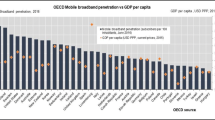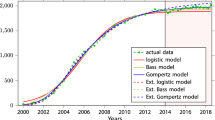Abstract
The objective of this paper is to investigate the impact of the time-delay effect on the diffusion of mobile telecommunication services in EU. It has been proved from several studies that the time-delay between the awareness and the adoption phase of mobile services-potential users determines the speed of the mobile telecommunication service diffusion and can be used effectively for ranking or cluster purposes in cases when the diffusion of a new product in different countries is studied. The proposed modeling approach originates from the well-known logistic model where it is assumed that the ordinary contagion process does not take place instantly but after some certain amount of time. A proper modification of the proposed model described by a time lag ordinary differential equation can be solved analytically and its properties for several parameters’ combination are investigated. Moreover, a new diffusion speed index is proposed and the correlation between the time-delay index and the proposed diffusion speed index is examined. Finally the model is applied to real data concerning the mobile services diffusion in 15 counties of EU from 1990 to 2002. Based on the estimated parameters of the model produced for each country a ranking and a clustering of the EU countries based on their derived diffusion speed and time-delay indexes are provided.
Similar content being viewed by others
References
Bakalis, S., Abeln, M., & Enid M.-M. (1997). The adoption and use of mobile telephony in Europe. In L. Haddon (ed.), Communications on the Move: The Experience of Mobile Telephony in the 1990s (pp. 1–10). COST248 Report.
Bass F. (1969). A new product growth model for consumer durables. Management Science, 15, 217–231
Blackman A.W. (1972). A mathematical model for trends forecasts. Technological Forecasting and Social Change, 3, 441–452
Dekimpe, M. G., Parker, P. M., & Sarvary, M. (1996). Comparing adoption patterns: A global approach. INSEAD Working Paper Series 96/37/MKT.
Fisher J.C., Pry R.H. (1971). A simple substitution model of technical change. Technological Forecasting and Social Change, 2, 75–88
Frank L. (2004). An analysis of the effect of the economic situation on modeling and forecasting the diffusion of wireless communications in Finland. Technological Forecasting and Social Change, 71(4):391–403
Giovanis A.N., Skiadas C.H. (1999). A stochastic Logistic innovation diffusion model studying the electricity consumption in Greece and the United States. Technological Forecasting and Social Change, 61, 235–246
Griliches Z. (1957). Hybrid corn: An exploration in the economics of technical change. Econometrica, 25, 501–522
Gruber H. (2001). Competition and innovation. The diffusion of mobile telecommunications in Central and Eastern Europe. Information Economics and Policy, 13, 19–34
Gruber H., Verboven F. (2001). The diffusion of mobile telecommunications services in the European Union. European Economic Review, 45, 577–588
Kumar U., Kumar V. (1992). Technological innovation diffusion: The proliferation of substitution models and easing the user’s dilemma. IEEE Transactions on Engineering Management, 39, 158–168
Mahajan V., Muller E., Bass F.M. (1990). New product diffusion models in marketing: A review and directions for research. Journal of Marketing, 54(1):1–26
Mansfield E. (1961). Technical change and the rate of imitation. Econometrica, 29, 741–765
Mead N., Islam T. (1998). Technological forecasting—model selection, model stability, and combining models. Management Science, 39(8):1115–1130
OECD: Communications Outlook, 2000- 2001–2002.
Poznanski K.Z. (1983). International diffusion of steel technologies. Time-lag and the speed of diffusion. Technological Forecasting and Social Change, 23, 305–323
Sharif M.N., Kabir C. (1976). A generalized model for forecasting technological substitution. Technological Forecasting and Social Change, 8, 353–364
Sharif M.N., Ramanathan K. (1984). Temporal models of innovation diffusion. IEEE Transactions on Engineering Management, 31, 76–86
Skiadas C.H. (1985). Two generalized models for forecasting innovation diffusion. Technological Forecasting and Social Change, 27, 39–61
Skiadas C.H. (1986). Innovation diffusion models expressing asymmetry and/or positively or negatively influencing forces. Technological Forecasting and Social Change, 30, 313–330
Skiadas C.H. (1987). Two simple models for early and middle stage prediction of innovation diffusion. IEEE Transactions on Engineering Management, 34, 79–84
Skiadas C.H. (1995). A Lagrangian approach for the selection of growth functions in forecasting. In: Janssen J., Skiadas C.H., Zopounidis C. (eds) Advances in stochastic modelling and data analysis. Dordrecht, Kluwer Academic Publishers
Skiadas C.H. (2005). Mathematical models of Chaos. In: Stavroulakis P. (eds) Chaos applications in Telecommunications. New York, Taylor and Francis
Skiadas, C. H., Rompogiannakis, G., Apostolou, A., & Dimoticalis, J. (2005). Chaotic aspects of a generalized rational model. In J. Janssen, & Ph. Lenca (eds.), Proceedings of the XIth international symposium on applied stochastic models and data analysis, ASMDA 2005, 17–20. May, 2005. Brest, France.
Wright M., Upritchard C., Lewis T. (1997). A validation of the Bass new product diffusion model in New Zealand. Marketing Bulletin, 8, 15–29
Author information
Authors and Affiliations
Corresponding author
Rights and permissions
About this article
Cite this article
Giovanis, A.N., Skiadas, C.H. A new modeling approach investigating the diffusion speed of mobile telecommunication services in EU-15. Comput Econ 29, 97–106 (2007). https://doi.org/10.1007/s10614-006-9067-x
Received:
Accepted:
Published:
Issue Date:
DOI: https://doi.org/10.1007/s10614-006-9067-x




